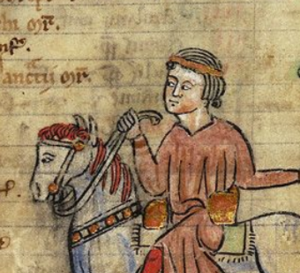Adolf Künkel
| Adolf Künkel | |
|---|---|
| King of Münich | |
 | |
| Petty King of Münich | |
| Reign | January 867 - 26 October 910 (43 years) |
| Predecessor | Bertrand (?) |
| Successor | Albricht Künkel |
| Born | Barony of Tölz |
| Buried | Eschenlohe Keep, Eschenlohe |
| Noble family | Künkel |
| Spouse(s) | Wulfhilde von Glarus |
| Father | Bertrand (?) |
| Mother | Unknown |
| Religion | Catholic |
Adolf Künkel sometimes called Adolf the Builder was Lord of Eschenlohe and later petty King of Münich from 867 until his death. He was the head of the Künkel dynasty and was responsible for guiding the Lordship of Eschenlohe through the aftermath of the Great Collapse and creating the petty Kingdom of Münich. We do not know whether Adolf's predecessor died or was deposed as most information was lost due to the Great Collapse. Nor do we know Adolf's exact relationship to Bertrand, though we can assume Adolf was a close relation if not his son.
The first significant event of Adolf's reign was marked by the marriage of Adolf to Wulfhilde von Glarus of Augsburg and creating a formal alliance with Lord Otto. With the political apparatus so fragile, creating a proper heir and a formal alliance gave much needed stability. Thereafter, Adolf spent much of his time and effort governing the lordship of Eschenlohe, only aggressively expanding three times during his reign. The first war fought by Adolf resulted in a defeat against the then independent lordship of Münich at the hands of the Augsburgians, who were at the time allied with both Münich and Lord Adolf. The result of the war put Adolf into significant debt and sour terms with Augsburg. The second expansive war was against the lorship of Schongau, resulting in a victory and the former lord relinquishing all land and title directly to Adolf. Years later, Adolf would launch a second war to take Münich, this time with greater success and no interference from Augsburg. The final war waged by Adolf was for Falkenstein, pressing a personal claim. Victorious and claiming the land of Falkenstein, Lord Adolf would go on to declare himself the petty King of Münich but choosing to keep the realm capital at Eschenlohe. The usage of the name Münich was only for denoting the region around the city of Munich.
Adolf had earned a reputation for being a builder and skilled architect, funding many development projects, most notably a massive irrigation project to bring water to previously unsuitable land and fostering logging operations in the densly wooded areas around Eschenlohe. Adolf was known for personally designing and overseeing the construction of many buildings in Eschenlohe
Adolf died in October of 910 at age 65. Upon his death, the petty Kingdom of Münich would be divided among Adolf's three sons. Albricht would become King of Münich and hold Eschenlohe and Falkenstein, Hunfried would hold the city of Münich and surrounding lands, and Adolf's youngest son Rudolf would be given Schongau and the city of Peiting. Adolf's remains were buried in the court graveyard near the keep in Eschenlohe